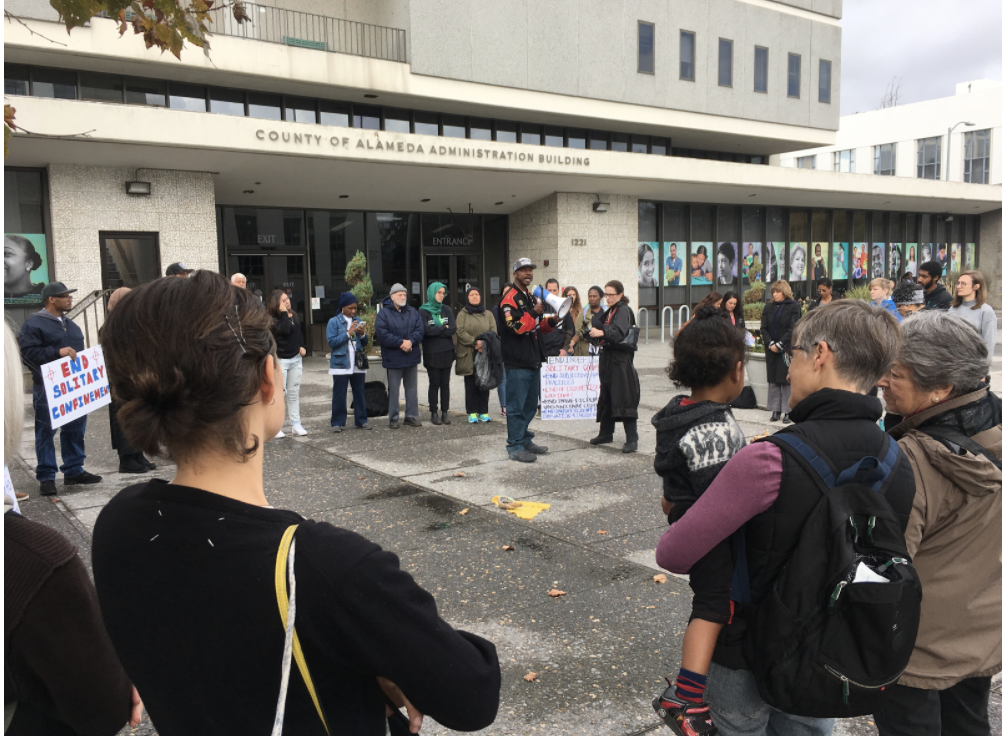
October 15th to October 19th, 126 prisoners went on a hunger strike at the Glenn Dyer Detention Facility in downtown Oakland. Their primary grievance was indefinite solitary confinement, a practice that continues due to semantic loopholes.
The strike was organized under the umbrella of Prisoners United, a coalition of incarcerated individuals representing jails and prisons across the Bay Area.
On Thursday morning, a group of family and friends of Prisoners United gathered outside of the Alameda County Administrative Building, located just a few blocks from Glenn Dyer. The Board of Supervisors was holding a Public Protection meeting and had agreed to hear their testimony, alongside a report from the Alameda County Sheriff’s Office.
Before attending the hearing, the group stood in a circle and went around sharing what the strike meant to them. One of the speakers was John Jones III, a community organizer and life coach for the Oakland-based Communities United for Restorative Youth Justice (CURYJ). He stressed that the strike wasn’t only about ending solitary confinement or allowing inmates to change their clothes more than once a week. It was about shared humanity, and recognizing the inmates as people. To the Sheriff and Board of Supervisors, he offered a simple demand: “These folks must honor life.”
Administrative Segregation
When individuals are arrested in Alameda County, they are either taken to Glenn Dyer or the larger Santa Rita Jail, which is the fifth largest in the country. This means that the majority of inmates housed at the two facilities have yet to be convicted.
Even so, 82 of the roughly 400 prisoners at Glenn Dyer are held in what is referred to as administrative segregation, where they are kept in cells separate from the general population for a minimum of 23 hours per day. As Sheriff’s Captain Dave Blanchard presented at the hearing, inmates can be held in administrative segregation for periods of weeks to even years.
According to Juan Méndez, the UN Special Rapporteur on torture, solitary confinement is defined as any practice where an inmate is held in isolation from others for at least 22 hours a day. He recommended an absolute prohibition on any prolonged solitary confinement that lasts longer than 15 days.
The Sheriff’s Office, however, denies that the inmates are held in solitary confinement. They refer to the practice as administrative segregation because their cells are not in total isolation. They can still hear other inmates. They just cannot leave their cells.
Moreover, inmates held in administrative segregation lose many of their visitation rights. According to Jones, the practice does not only impact the inmates. It also impacts their families. At the hearing, he testified that one of the dehumanizing aspects of imprisonment is reducing people to names like “inmate, convict, and criminal,” when they are actually “son, mother, and loved one.”
Compounding the problem is the issue of classification. Glenn Dyer ostensibly institutes administrative segregation for the prisoners’ own safety. Their aim is to separate potential gang members from the general population.
To achieve this, the jail classifies inmates as they enter, designating inmates as gang members and subjecting them to administrative segregation without a transparent process or the ability to appeal.
Hunger Strikes
California prisons have a long history of hunger strikes. Almost 30,000 California prisoners participated in a hunger strike in 2013, protesting the same issue of indefinite solitary confinement. The strike originated from Security Housing Unit, or SHU, at the Pelican Bay State Prison, where prisoners were confined indefinitely for a minimum of 22.5 hours a day.
The hunger strike resulted in the class action lawsuit Ashker v. Governor of California, brought forward by inmates housed in the SHU, including leaders and participants of the hunger strike. The case was held in September 2015 and resulted in the end of indefinite SHU terms in California state prisons, as well as a reduction in the amount of inmates held in solitary confinement. While inmates had previously been subjected to the SHU for decades, the maximum confinement term was restricted to ten years.
In October 2016, more than 100 inmates at the Santa Clara County jails held a hunger strike to protest continued grievances regarding solitary confinement. While Santa Clara County Sheriff Laurie Smith maintained that solitary confinement had been abolished, inmates asserted that any free time was held in virtual isolation. Furthermore, an inmates’ advocacy group filed a lawsuit claiming that one prisoner had not seen sunlight or breathed fresh air for seven months.
While the hunger strike was supposed to last for two weeks, the inmates ended it after three days because they thought their demands were being addressed. However, no indication of progress was made in the following year. Prisoners United formed to revive the hunger strikes.
Next Steps
Alongside Glenn Dyer, Prisoners United is also planning hunger strikes in Santa Clara County Main Jail, Elmwood Correctional Complex, and the Santa Rita Jail.
The group organized outside of the administrative building on Thursday came to represent the incarcerated. Some were loved ones, some were local activists. They each had a story to share.
One man, Dauras Cyprian, came with the community organization All of Us or None. He had been incarcerated for 26 years, spending six of them in solitary confinement. Since leaving prison, he has worked for the Ban-the-Box movement, which would make it illegal for employers to include application questions on an applicant’s conviction history. He is also earning his baccalaureate degree in social work.
Like Jones, Cyprian emphasized that Prisoners United was not only fighting for issues like solitary confinement. They were fighting for awareness. According to Cyprian, the public needs to understand the dehumanizing conditions that inmates are subjected to, and why it is so difficult for many to return to society after the ordeals they face in jail.
At the hearing, Alameda County Supervisors Scott Haggerty and Richard Valle listened compassionately to the testimony. They indicated they would put pressure on the Sheriff’s Office to make changes, with Supervisor Valle saying “How we treat each other as human beings is critically important.”
The people in the room had heard similar rhetoric before. The next hunger strike is always in the works. ≠

